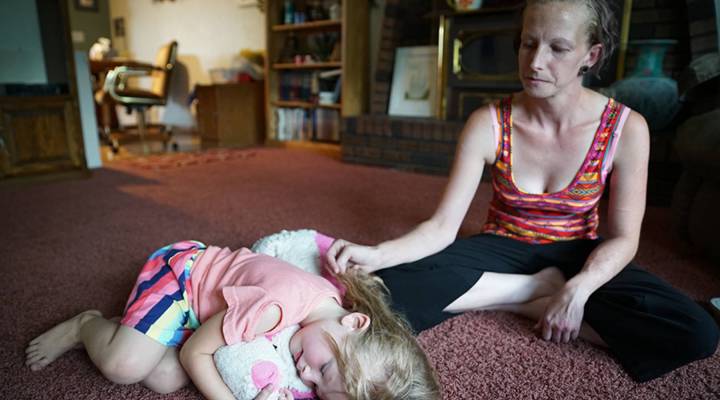
Utah’s approach to breaking the cycle of child poverty: helping parents
Utah’s approach to breaking the cycle of child poverty: helping parents

“If I didn’t have my grandparents, I would definitely be in a shelter right now,” said Stephanie Snowball just hours before picking her three-year-old daughter and seven-year-old son from daycare in Salt Lake City. The 34-year-old single mother has one source of income: state assistance for food and childcare. She tries to save on expenses whenever she can. Most weekdays, it means picking her kids up from daycare around 5:30 pm, right after dinnertime.
“They like the food,” she said.
Snowball is one of 99,181 adults and children in Utah that the state considers living in intergenerational poverty. She’s had her share of obstacles. She grew up in a rural Kearns, Utah with parents she said did what they could for her and her siblings. But things took a turn for the worse after her parents divorced when she was nine.
“Then my dad turned to drugs; my mom was an alcoholic,” she said. “We kind of raised ourselves and just kept going with the struggle.”
Snowball has been through evictions and health issues, with one of her latest obstacles being a divorce from a substance abuser. Snowball is hoping to break the cycle of struggle for her kids’ sake.
“I can’t just sit in this struggle,” she said.
Stephanie Snowball is hoping to find a decent job so she won’t have to rely on state aid.
According to the U.S. Census, 40.6 million adults and children are living in poverty. That’s almost 13 percent of the nation’s population. A recent study from the Annie E. Casey Foundation finds that Utah is leading states in efforts to reduce childhood poverty. Utah lawmakers passed legislation in 2012 requiring Utah to focus on reducing its poverty rate.
One initiative, in particular, called Invest in You Too, is meant to remove obstacles that keep more than a quarter of adults living in intergenerational poverty. The thirteen-week program gives single mothers on state assistance job training and life skills coaching.
“We have some people that were on drugs and now they’re two years sober and now they’re in our program,” said Danielle White, a family success coach for Invest in You Too.
White has helped teach program participants a range of skills — like how to budget, set goals, and write a resume. The women are all working toward a certificate in medical device manufacturing, a booming industry in Utah. White said they have a shot a jobs thanks to the program’s relationships with companies.
“Our referral with the employers does hold a lot of weight because it shows we’ve vetted them a little bit and they are ready for work,” she added.
Invest in You Too is funded through grants from the federal Temporary Assistance for Needy Families program. That money has helped nearly three dozen women secure jobs in the past year and a half.
“Sometimes we think that we can get away with giving just a little bit but if you truly want to innovate and see change, you have to invest in that,” said Liz Carver, Workforce Development Program Division Director for the Utah Department of Workforce Services.
According to Pam Perlich, an economic demographer at the University of Utah, programs like Invest in You Too are critical because escaping poverty is getting harder.
“As the cost of housing and transportation and medical care, all of that have continued to go up, we know that’s the case for many households across the country,” she said.
Perlich said the challenge for state agencies has been rapid population growth and a changing economy.
The state of Utah plans to continue Invest in You Too and start a program that helps fathers.
In the meantime, Stephanie Snowball is preparing to graduate from the program and is hoping to land a job making at least $13.25 an hour.
Stephanie Snowball is hoping to secure a job in the medical manufacturing industry after completing Invest in You Too.
Her ultimate goal is to get her own place, pay her own bills, and be independent.
“Somebody my kids can look up to,” she said.
| Utah is reducing its child poverty rate, one piece of data at a time |
| About half of American households are unable to save for emergencies |
There’s a lot happening in the world. Through it all, Marketplace is here for you.
You rely on Marketplace to break down the world’s events and tell you how it affects you in a fact-based, approachable way. We rely on your financial support to keep making that possible.
Your donation today powers the independent journalism that you rely on. For just $5/month, you can help sustain Marketplace so we can keep reporting on the things that matter to you.


















